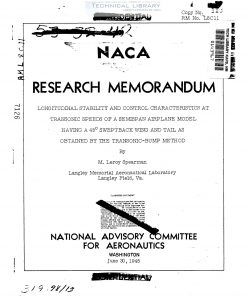naca-rm-l8c11
- Version
- 74 Downloads
- 2.80 MB File Size
- 1 File Count
- April 24, 2017 Create Date
- April 24, 2017 Last Updated
National Advisory Committee for Aeronautics, Research Memorandum - Longitudinal Stability and Control Characteristics at Transonic Speeds of a Semispan Airplane Model Having a 45° Sweptback Wing and Tail as Obtained by the Transonic Bump Method

An investigation has been made in the Langley high-speed 7- by lOnfoot
tunnel using the transonic-bump method to determine the longitudinal
stability and control characteristics at transonic speeds of a semispan
airplane model having a #50 sweptback wing and tail.
The results of the investigation indicated an increase in the rate
of change of pitching-moment coefficient with lift coefficient at a
constant Mach number (E§E§ through the transonic range that was
attributed to a rearward shift of the wing-fuselage aerodynamic-center
location at subsonic Speeds and to a rapid decrease in downwash at
supersonic speeds.
At a Mach number of about 0-95 a moderate decrease occurred in both
the lift-curve slope and in the stabilizer effectiveness. The high
angle of sweep was effective in delaying the drag rise at zero angle of
attack up to a Mach number of about 0.95.
The curve of stabilizer incidence required for trim against Mach
number had an unstable variation between a Mach number of 0.90 and 1.20,
but trim could be maintained throughout the Mach number range with a
stabilizer deflectibn of only slightly more than 10.
Tests were made by the transonic-bump method to determine the
longitudinal stability and control characteristics in the transonic
range of a semispan airplane model having a ABC sweptback wing and tail.
The tail was placed directly behind the wi for these tests. The tests
were made through a Mach number 3f - 'ifi t 0-50 to 1.23.
The model was mounted on a strain-gage balance and the lift, drag,
and pitching moment were measured with a calibrated galvanometer- The
angle of attack was changed with a small electric motor and the angle
was determined with a calibrated slide-wire potentiometer.
| File | Action |
|---|---|
| naca-rm-l8c11 Longitudinal Stability and Control Characteristics at Transonic Speeds of a Semispan Airplane Model Having a 45° Sweptback Wing and Tail as Obtained by the Transonic Bump Method.pdf | Download |

Comment On This Post